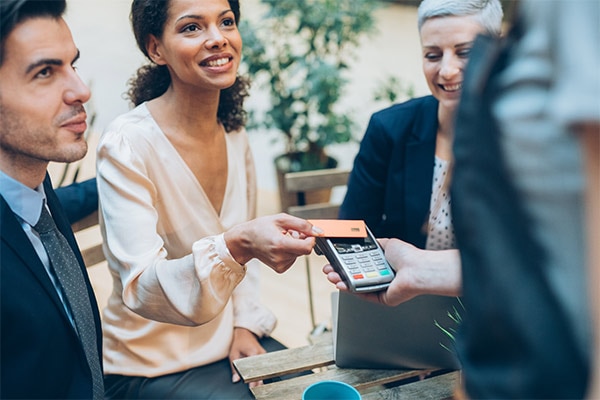Limitations apply. Notify PNC Bank immediately of any unauthorized use. For specific time restrictions, limitations and other details regarding unauthorized use, see your account agreement.
Contactless Cards Make Checking Out Easier
Pay with just a tap
Contactless Cards Make Checking Out Easier
Pay with just a tap
Speed
Pay in seconds without swiping or inserting your card at the checkout terminal.
Convenience
Just tap to pay where you see the EMVCo Contactless Indicator.
Security
Get the same level of security when you tap as you do when you insert your chip.
Contactless Card Technology

Contactless cards make it fast and easy for you to pay for everyday purchases at merchants around the world.
You'll still get the same level of security when you tap as you do when you insert your chip while enjoying the added convenience without having to swipe or insert your card at the checkout terminal. Just tap to pay where you see the EMVCo Contactless Symbol.
Tap to Pay
Pay in seconds without swiping or inserting your card.
Frequently Asked Questions
All new PNC cards are contactless, if you already have a PNC credit or debit card you can use the link below to upgrade your card. If you are not a already existing PNC customer feel free to apply using the links below.
Look for the EMVCo Contactless Indicator 
If you would like to replace an existing PNC card, you can do so in Online Banking, the PNC Mobile Banking app, or by calling the phone number on the back of your card.
Contactless payments use short range NFC (near field communication) technology to securely complete payments between a contactless card and a contactless-enabled checkout terminal. Once you tap the card at a contactless-enabled terminal, your payment is sent for authorization.
Your card must be within 1-2 inches of the Contactless Symbol ![]() on the terminal.
on the terminal.
Typically, the terminal reads the antenna best when your PNC Visa contactless card is flat over the Contactless Symbol.![]() However, some contactless readers will function best if you tap the chip to the actual payment reader.
However, some contactless readers will function best if you tap the chip to the actual payment reader.
- Speed – Pay in seconds without swiping or inserting your card.
- Convenience – Just tap to pay where you see the Contactless Symbol.

- Security – Get the same level of security when you tap as you do when you insert your chip. Your card number and personal information are never transmitted with the transaction, and you have Zero Liability Fraud Protection[1] when using your PNC Visa card.
All PNC cards with the Contactless Indicator 
You can tap to pay where you see the Contactless Symbol ![]() at checkout. Many merchants around the world accept contactless payments. If you are making a purchase at a merchant that cannot accept contactless payments, you can still swipe or insert your contactless card, just like any other Visa card.
at checkout. Many merchants around the world accept contactless payments. If you are making a purchase at a merchant that cannot accept contactless payments, you can still swipe or insert your contactless card, just like any other Visa card.
If you do not see the Contactless Indicator 
The security of your personal and financial information is a priority for PNC. These measures help protect you when you make contactless payments:
- Your actual card number and personal information are never passed with the transaction, instead using a one-time security pass code to protect your payment information.
- You must be within 2 inches for the card to transact from a terminal.
- You have Zero Liability Fraud Protection[1] when using your PNC Visa card.
To protect your card number, the card securely transmits a unique one-time code that changes for every in-person transaction and encrypts your payment information. The unique code is different than your card number.
Contactless payments require the merchant to initiate the payment process. Once initiated, you must place your card or device within one to two inches of the payment terminal. The radio antenna then picks up your card’s signal for the transaction to complete, significantly reducing the possibility of an unintentional payment.
Yes. If you don’t see the Contactless Symbol ![]() on the checkout terminal, you can still swipe or insert your contactless card, just like any other Visa card.
on the checkout terminal, you can still swipe or insert your contactless card, just like any other Visa card.
To protect your card number, for every contactless transaction, a unique transaction-specific code is created that secures the cardholder’s payment information. Due to the nature of the code and additional fraud protection processes, your data could not be utilized to perform a transaction more than one time.


